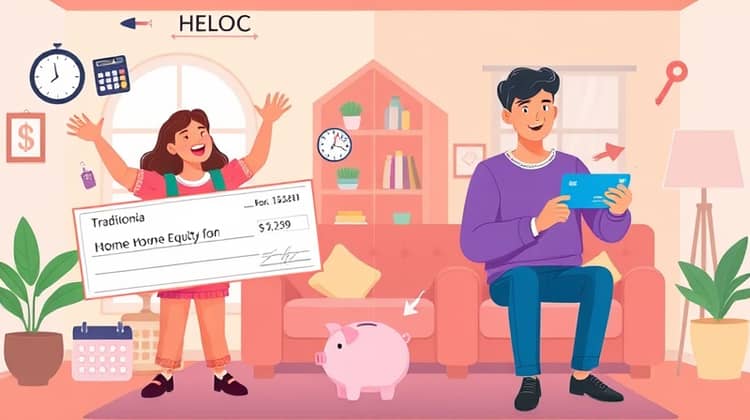Home Equity Lines of Credit (HELOC) have gained popularity among homeowners as a flexible alternative to traditional loans. They allow you to tap into your home's equity, providing you with the funds necessary for various financial needs such as home improvements, debt consolidation, or unexpected expenses. Understanding how a HELOC works, its benefits, and the potential risks associated with it can help you make an informed decision on whether it is the right choice for your financial situation.
A HELOC is essentially a revolving line of credit that uses your home as collateral. Unlike a standard home equity loan that provides a lump sum, a HELOC allows you to borrow up to a certain limit, pay it off, and borrow again as needed. This flexibility makes it a compelling option for many homeowners, especially those who prefer to manage their finances with more discretion.
What Is a HELOC?

A Home Equity Line of Credit, commonly known as a HELOC, is a financial product that allows homeowners to borrow against the equity they have built in their homes. Equity is calculated as the difference between your home’s market value and the balance owed on your mortgage. By leveraging this equity, homeowners can access a substantial amount of money without needing to sell their property.
HELOCs are often appealing because they tend to have lower interest rates than personal loans or credit cards. This is mainly due to the fact that they are secured by the property itself, making them less risky for lenders. As a result, many homeowners turn to HELOCs for major expenses, renovations, or as a financial safety net.
How Does a HELOC Work?

HELOCs operate much like credit cards, where a financial institution gives you a maximum loan limit based on the equity in your home. During the draw period, which can last several years, borrowers can withdraw funds up to their approved limit. Repayments typically include interest only, making small monthly payments manageable during this initial phase.
Once the draw period ends, the homeowner enters the repayment period, during which any outstanding balance must be paid down with both principal and interest. This period can significantly increase monthly payments, making it important for homeowners to be prepared for this transition.
- Apply for a HELOC with a lender.
- Receive a credit limit based on your equity.
- Withdraw funds as needed during the draw period.
- Make interest-only payments during the draw period.
- Transition to full repayment phase, paying both principal and interest.
The flexibility of HELOCs provides homeowners with easy access to cash whenever required, but it’s essential to remain diligent about repayments and budgeting for future payments once the draw period concludes.
How to Qualify for a HELOC

Qualifying for a HELOC involves meeting several criteria set by lenders. Generally, lenders look at your credit score, current income, and the amount of equity you have in your home. A decent credit score, often 620 or higher, is crucial as it reflects your creditworthiness and ability to repay the borrowed amount.
Equity is another significant factor in deciding how much you can borrow through a HELOC. Most lenders allow you to borrow up to 85% of your home’s equity, factoring in your existing mortgage balance. You can calculate your equity by subtracting your mortgage balance from your home’s current market value.
- Check your credit score and financial history.
- Determine your home’s market value.
- Calculate the available equity in your home.
- Research different lenders and their qualifications.
- Submit an application with necessary documentation.
By ensuring you meet these criteria, potential borrowers can increase their chances of securing a HELOC at favorable terms.
How to Get a HELOC

Obtaining a HELOC involves several steps. Homeowners should begin by evaluating their financial needs and deciding on the amount they wish to borrow. Gathering the necessary documents such as income verification, credit reports, and home valuation will facilitate a smoother application process.
Once you have a clear understanding of your financial objectives, the next step is to shop around for the best lender and loan terms that fit your situation.
- Evaluate your financial needs and determine the desired HELOC amount.
- Gather necessary documents for application.
- Research and compare lenders and their offerings.
- Submit your application and wait for approval.
- Review and understand terms before acceptance.
Once your application is approved, you will be able to access the funds through checks, debit cards, or online transfers, making it a convenient option for homeowners.
HELOC Costs

While a HELOC can provide financial flexibility, it comes with associated costs that homeowners need to be aware of. Initial costs can include appraisal fees, closing costs, and possible annual fees. Lenders may also charge a membership fee to open an account. Understanding these costs upfront can help you make an informed decision about whether a HELOC is worth pursuing.
In addition to the upfront costs, borrowers must also prepare for the interest rates, which can be variable and fluctuate over time. This can sometimes lead to larger payments if interest rates rise, leaving borrowers with unexpected financial obligations.
- Appraisal fees for property assessment.
- Closing costs associated with the loan.
- Annual fees charged by lenders.
- Potential cancellation fees if you close the HELOC early.
- Variable interest rates impacting overall cost.
Understanding all associated costs is crucial as it helps borrowers to budget effectively and avoid surprises during the loan's lifespan.
Advantages and Disadvantages of a HELOC

A HELOC provides several benefits but also comes with substantial risks that potential borrowers should consider. The flexibility in borrowing and the ability to reuse credit as needed can be invaluable for homeowners. Furthermore, the interest rates are generally lower compared to unsecured loans, which can save money over time.
However, the risks include variable interest rates leading to fluctuating payments and the looming danger of foreclosure if the borrower fails to make the necessary payments, as the home functions as collateral.
- Lower interest rates than unsecured loans.
- Flexible borrowing and repayment options.
- Access to funds for various financial needs.
- Potential tax advantages for home improvement expenses.
Homeowners must weigh both the advantages and disadvantages carefully to determine if a HELOC aligns with their financial strategy.
HELOC vs. Home Equity Loan

When comparing a HELOC with a traditional home equity loan, it's crucial to understand the main differences. While both allow homeowners to borrow against the equity in their home, a home equity loan offers a lump sum with fixed monthly payments, whereas a HELOC provides a revolving line of credit with flexible payments.
Choosing between the two usually depends on an individual's financial needs and preferences for payment structures.
- HELOC offers flexible borrowing and repayment options.
- A home equity loan has a fixed interest rate and monthly payments.
- HELOC allows for repeated access to funds, while home equity loans do not.
- Home equity loans provide a lump sum for immediate needs.
Evaluating your financial goals will help you decide which option best fits your situation.
Do You Have to Pay a HELOC Back?

Yes, you must pay back any amount borrowed through a HELOC. During the draw period, most homeowners will only be required to make interest payments on the balance used, but once the draw period ends, they will need to repay both the principal and interest. This is important to consider as payments can significantly increase after transitioning to the repayment period.
Failure to make timely payments can result in foreclosure, as the type of loan is secured against your home. Borrowers must manage their budgets accordingly to ensure they can meet repayment terms throughout the life of the HELOC.
Can You Take Money Out of a HELOC?

Yes, as long as you are within the draw period, you can take money out of a HELOC as needed, up to your credit limit. Borrowers have various options to access funds, such as checks, online transfers, or debit cards linked to the HELOC account.
It is vital to be mindful of the repayment terms and conditions, as withdrawing more than you can afford to pay back can lead to serious financial issues down the road.
What Happens if You Don't Use Your HELOC?

If you don’t use your HELOC, there's typically no cost associated with it during the draw period. However, once the draw period is over, fees may apply to maintain the line of credit if it is not used or if it falls below a certain threshold. It's also important to note that lenders may periodically review accounts even when inactive, which can impact your credit limit.
In some cases, if a HELOC remains unused for an extended period, the lender may require you to close it or may reduce your borrowing limit.
How Does a HELOC Work After You Sell Your House?

When you sell your house, any outstanding balance on your HELOC must be paid off. This payment typically occurs at the time of closing when the sale proceeds are used to settle any remaining debts, including your mortgage and any lines of credit secured by the property.
It’s essential to remind potential sellers to account for these obligations early in the selling process to ensure that they can effectively manage their finances post-sale.
The Bottom Line

In conclusion, a Home Equity Line of Credit (HELOC) can be an effective way for homeowners to access their home equity for various financial needs. It offers flexibility and potentially lower interest rates compared to other types of loans. However, it also presents unique risks and costs that borrowers should consider carefully before proceeding.
Potential borrowers should take the time to research various lenders, compare terms and rates, and understand their financial situations fully. Having a solid plan for repayment and an emergency budget can help mitigate potential risks associated with HELOCs.
Ultimately, whether a HELOC is right for you depends on your specific financial goals, your comfort with the associated risks, and your ability to safely manage the borrowed funds.














